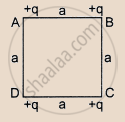Advertisements
Advertisements
Question
Ten positively-charged particles are kept fixed on the x-axis at points x = 10 cm, 20 cm, 30 cm, ...., 100 cm. the first particle has a charge 1.0 × 10−8 C, the second 8 × 10−8 C, the third 27 × 10−8 C and so on. The tenth particle has a charge 1000 × 10−8 C. Find the magnitude of the electric force acting on a 1 C charge placed at the origin.
Solution
By Coulomb's Law, force (F) on charge q due to one charge,
\[F = F_1 + F_2 + F_3 + . . . . . + F_{10} \]
\[ = 9 \times {10}^9 \times \left[ \frac{1 . 0}{\left( 0 . 10 \right)^2} + \frac{8}{\left( . 20 \right)^2} + \frac{27}{\left( . 30 \right)^2} + . . . . . . \frac{1000}{\left( 1 . 0 \right)^2} \right] {10}^{- 8} \]
\[ = \frac{9 \times {10}^9 \times {10}^{- 8}}{{10}^{- 2}}\left[ 1 + 2 + 3 + . . . . . . 10 \right]\]
\[ = 9 \times {10}^3 \times 55\]
\[ = 4 . 95 \times {10}^5\] N
APPEARS IN
RELATED QUESTIONS
Two equal charges are placed at a separation of 1.0 m. What should be the magnitude of the charges, so that the force between them equals the weight of a 50 kg person?
Three equal charges, 2.0 × 10−6 C each, are held at the three corners of an equilateral triangle of side 5 cm. Find the Coulomb force experienced by one of the charges due to the other two.
Four equal charges of 2.0 × 10−6 C each are fixed at the four corners of a square of side 5 cm. Find the Coulomb's force experienced by one of the charges due to the other three.
A particle A with a charge of 2.0 × 10−6 C is held fixed on a horizontal table. A second charged particle of mass 80 g stays in equilibrium on the table at a distance of 10 cm from the first charge. The coefficient of friction between the table and this second particle is μ = 0.2. Find the range within which the charge of this second particle may lie.
A particle A with a charge of 2.0 × 10−6 C and a mass of 100 g is placed at the bottom of a smooth inclined plane of inclination 30°. Where should another particle B, with the same charge and mass, be placed on the incline so that it may remain in equilibrium?
Two particles A and B possessing charges of +2.00 × 10−6 C and of −4.00 × 10−6 C, respectively, are held fixed at a separation of 20.0 cm. Locate the points (s) on the line AB, where (a) the electric field is zero (b) the electric potential is zero.
A water particle of mass 10.0 mg and with a charge of 1.50 × 10−6 C stays suspended in a room. What is the magnitude of electric field in the room? What is its direction ?
Two equal charges, 2.0 × 10−7 C each, are held fixed at a separation of 20 cm. A third charge of equal magnitude is placed midway between the two charges. It is now moved to a point 20 cm from both the charges. How much work is done by the electric field during the process?
Answer the following question.
What is relative permittivity?
Write down Coulomb’s law in vector form and mention what each term represents.
Two-point charges of + 0.2 µµC and -0.2 µµC are separated by 1 o8 m. What is the value of the electric field at an axial point at a distance of 0.1 m from their mid-point?
The unit of charge is ______.
Four equal charges q are placed at the four comers A, B, C, D of a square of length a. The magnitude of the force on the charge at B will be ______.

Two charges of equal magnitudes kept at a distance r exert a force F on each other. If the charges are halved and distance between them is doubled, then the new force acting on each charge is ______.
Coulomb's law is given by F = k q1q2 rn where n is
According to Coulomb's law, which is the correct relation for the following figure?

What is meant by the statement: "Relative permittivity of water is 81"?
